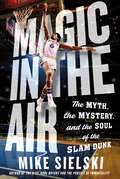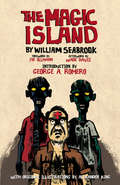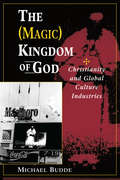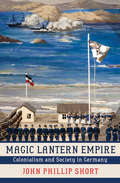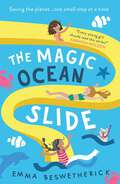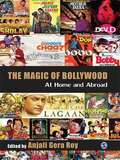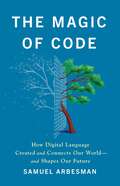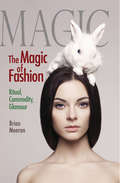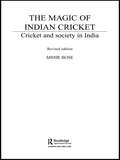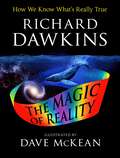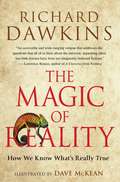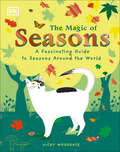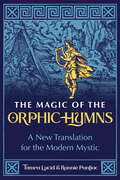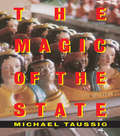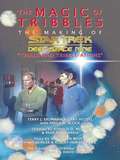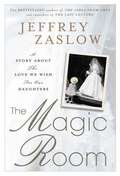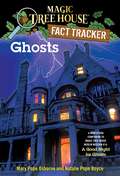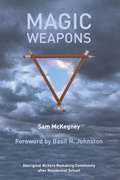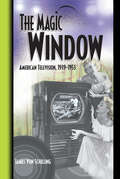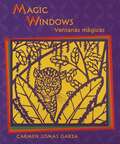- Table View
- List View
Magic in the Air: The Myth, the Mystery, and the Soul of the Slam Dunk
by Mike Sielski"Who doesn't wanna read an entire book about the slam dunk? I love basketball." - Ann Patchett "The definitive dunking dissertation." - Jack McCallum, Wall Street JournalFrom the author of the bestselling Kobe Bryant biography The Rise comes the legend of the most powerful shot in basketball: the slam dunk.The evolution of basketball, and much of the social and cultural change in America, can be traced through one powerful act on the court: the slam dunk. The dunk's history is the story of a sport and a country changed by the most dominant act in basketball, and it makes Magic in the Air a rollicking and insightful piece of narrative history and a surefire classic of sports literature.When basketball was the province of white men, the dunk acted as a revolutionary agent, a tool for players like Wilt Chamberlain and Bill Russell to transform the sport into a Black man’s game. The dunk has since been an expression of Black culture amid the righteous upheaval of the civil-rights movement, of the threat that Black people were considered to be to the establishment. It was banned from college basketball for nearly a decade—an attempt to squash the individual expression and athleticism that characterized the sport in America’s cities and on its playgrounds. The dunk nevertheless bubbled up to basketball’s highest levels. From Julius Erving to Michael Jordan to the high flyers of the 21st century, the dunk has been a key mechanism for growing the NBA into a global goliath.Drawing on deep reporting and dozens of interviews with players, coaches, and other hoops experts, Magic in the Air brings to life the tale of the dunk while balancing sharp socio-racial history and commentary with a romp through American sports and culture. There's never been a basketball book quite like it.
Magic in the Middle Ages
by Richard KieckheferComparison of the different types of Magic used in the Middle Ages and their impact on the people. (ie Necromancy, Astrology, Science)
The Magic Island
by William Seabrook George A. Romero Joe Ollmann Alexander King"The best and most thrilling book of exploration that we have ever read ... [an] immensely important book." -- New York Evening Post"A series of excellent stories about one of the most interesting corners of the American world, told by a keen and sensitive person who knows how to write." -- American Journal of Sociology"It can be said of many travelers that they have traveled widely. Of Mr. Seabrook a much finer thing may be said -- he has traveled deeply." -- The New York Times Book ReviewThis fascinating book, first published in 1929, offers firsthand accounts of Haitian voodoo and witchcraft rituals. Journalist and adventurer William Seabrook introduced the concept of the walking dead - zombies - to the West with his illustrated travelogue. He relates his experiences with the voodoo priestess who initiated him into the religion's rituals, from soul transference to resurrection. In addition to twenty evocative line drawings by Alexander King, this edition features a new Foreword by cartoonist and graphic novelist Joe Ollmann, a new Introduction by George A. Romero, legendary director of Night of the Living Dead, and a new Afterword by Wade Davis, Explorer in Residence at the National Geographic Society.
The (Magic) Kingdom Of God: Christianity And Global Culture Industries
by Michael L BuddeIn The (Magic) Kingdom of God, Michael Budde offers a multidisciplinary analysis of the “global culture industries”-increasingly powerful, centralized corporate conglomerates in television, advertising, marketing, movies, and the like-and their impact on Christian churches in industrialized countries. Utilizing ideas from contemporary and classical
Magic Lantern Empire: Colonialism and Society in Germany
by John Phillip ShortMagic Lantern Empire examines German colonialism as a mass cultural and political phenomenon unfolding at the center of a nascent, conflicted German modernity. John Phillip Short draws together strands of propaganda and visual culture, science and fantasy to show how colonialism developed as a contested form of knowledge that both reproduced and blurred class difference in Germany, initiating the masses into a modern market worldview. A nuanced account of how ordinary Germans understood and articulated the idea of empire, this book draws on a diverse range of sources: police files, spy reports, pulp novels, popular science writing, daily newspapers, and both official and private archives.In Short's historical narrative-peopled by fantasists and fabulists, by impresarios and amateur photographers, by ex-soldiers and rank-and-file socialists, by the luckless and bored along the margins of German society-colonialism emerges in metropolitan Germany through a dialectic of science and enchantment within the context of sharp class conflict. He begins with the organized colonial movement, with its expert scientific and associational structures and emphatic exclusion of the "masses." He then turns to the grassroots colonialism that thrived among the lower classes, who experienced empire through dime novels, wax museums, and panoramas. Finally, he examines the ambivalent posture of Germany's socialists, who mounted a trenchant critique of colonialism, while in their reading rooms workers spun imperial fantasies. It was from these conflicts, Short argues, that there first emerged in the early twentieth century a modern German sense of the global.
The Magic Ocean Slide: Playdate Adventures (The Playdate Adventures)
by Emma Beswetherick&“Guaranteed free of unicorns and princesses, it&’s fun, empowering fiction for 5-8 year olds.&” David Nicholls, author of One Day &“Every young girl should read this series!&” Amanda Holden &“I loved learning about how the ocean is in trouble.&” Tess, age 6 Join best friends Katy, Cassie and Zia on a series of amazing adventures as they work together to save the planet… On the hottest day of the year, the friends imagine a water slide coming out of Katy&’s bedroom window. As they plunge into an underwater world, they can&’t wait to explore. But when they meet a dolphin in distress, they realise the ocean is in big trouble. It&’s so full of plastic that the sea creatures have been forced to flee their homes. Can the friends come up with a plan to put things right?
The Magic Ocean Slide: Playdate Adventures (The Playdate Adventures)
by Emma Beswetherick&“Guaranteed free of unicorns and princesses, it&’s fun, empowering fiction for 5-8 year olds.&” David Nicholls, author of One Day &“Every young girl should read this series!&” Amanda Holden &“I loved learning about how the ocean is in trouble.&” Tess, age 6 Join best friends Katy, Cassie and Zia on a series of amazing adventures as they work together to save the planet… On the hottest day of the year, the friends imagine a water slide coming out of Katy&’s bedroom window. As they plunge into an underwater world, they can&’t wait to explore. But when they meet a dolphin in distress, they realise the ocean is in big trouble. It&’s so full of plastic that the sea creatures have been forced to flee their homes. Can the friends come up with a plan to put things right?
The Magic of Bollywood
by Anjali Gera RoyFew would deny that the most significant weapon in India's cultural and artistic armory is its avowedly commercial cinema, now known as Bollywood. This anthology aims to portray the "soft" power of Bollywood, which makes it a unique and powerful disseminator of Indian culture and values abroad. The essays in the book examine Bollywood's popularity within and outside South Asia, focusing on its role in international relations and diplomacy. In addition to contributions that directly engage with the notion of soft power, a number of essays in the volume testify to the attractiveness of Bollywood cinema for ethnically diverse groups across the world, probe the reasons for its appeal, and explore its audiences' identification with cinematic narratives. Established and emerging scholars in literature, theater, film, dance, music, media, cultural studies, and sociology from different parts of the world present their views from multidisciplinary perspectives based on case studies from Australia, New Zealand, the UK, Germany, Russia, the US, Senegal, Pakistan, Bangladesh, Indonesia and Canada, in addition to India.
The Magic of Code: How Digital Language Created and Connects Our World—and Shapes Our Future
by Samuel ArbesmanIn the tradition of classics such as The Lives of a Cell, a bold reframing of our relationship with technology that argues code is "a universal force—swirling through disciplines, absorbing ideas, and connecting worlds" (Linda Liukas). In the digital world, code is the essential primary building block, the equivalent of the cell or DNA in the biological sphere—and almost as mysterious. Code can create entire worlds, real and virtual; it allows us to connect instantly to people and places around the globe; and it performs tasks that were once only possible in science fiction. It is a superpower, and not just in a technical sense. It is also a gateway to ideas. As vividly illustrated by Samuel Arbesman, it is the ultimate connector, providing new insight and meaning into how everything from language and mythology to biblical texts, biology, and even our patterns of thought connect with the history and nature of computing. While the building block of code can be used for many wondrous things it can also create deeper wedges in our society and be weaponized to cause damage to our planet or our civilization. Code and computing are too important to be left to the tech community; it is essential that each of us engage with it. And we fail to understand it to our detriment. By providing us with a framework to think about coding and its effects upon the world and placing the past, current, and future developments in computing into its broader setting we see how software and computers can work for people as opposed to against our needs. With this deeper understanding into the &“why&” of coding we can be masters of technology rather than its subjects.
The Magic of Fashion: Ritual, Commodity, Glamour (Anthropology and Business)
by Brian MoeranDrawing on 20 years of ethnographic fieldwork and anthropological theory, anthropologist Brian Moeran argues that fashion magazines are able to cast a spell over their readers by using practices and rituals found in age-old magical and religious rites.
The Magic of Indian Cricket: Cricket and Society in India (Sport in the Global Society)
by Mihir BoseIn the last twenty years, Indian cricket has been transformed. With the arrival of global television networks, mass-media coverage and multinational sponsors, cricket has become big business and India has become the economic driving force in the world game. For the first time a developing country has become a major player in the international sports arena. This fully updated and revised edition of Mihir Bose's classic history is a unique account of the Indian cricket phenomenon. Drawing on a combination of extensive research and personal experience, Bose traces the development of the Indian game from its beginnings as a colonial pastime to its coming of age as a national passion and now a global commercial powerhouse. This illuminating study reveals Indian cricket's central place in modern India’s identity, culture and society. Insightful, honest and challenging, Bose tackles the myths and controversies of Indian cricket. He considers the game in terms of race, caste, politics, national consciousness and ambition, money, celebrity and the media, evoking all the unpredictability, frustration and glory that is the magic of Indian cricket.
The Magic of Reality: How We Know What's Really True
by Richard DawkinsMagic takes many forms. Supernatural magic is what our ancestors used in order to explain the world before they developed the scientific method. The ancient Egyptians explained the night by suggesting the goddess Nut swallowed the sun. The Vikings believed a rainbow was the gods’ bridge to earth. The Japanese used to explain earthquakes by conjuring a gigantic catfish that carried the world on its back—earthquakes occurred each time it flipped its tail. These are magical, extraordinary tales. But there is another kind of magic, and it lies in the exhilaration of discovering the real answers to these questions. It is the magic of reality—science. Packed with clever thought experiments, dazzling illustrations and jaw-dropping facts, The Magic of Reality explains a stunningly wide range of natural phenomena. What is stuff made of? How old is the universe? Why do the continents look like disconnected pieces of a puzzle? What causes tsunamis? Why are there so many kinds of plants and animals? Who was the first man, or woman? This is a page-turning, graphic detective story that not only mines all the sciences for its clues but primes the reader to think like a scientist as well. Richard Dawkins, the world’s most famous evolutionary biologist and one of science education’s most passionate advocates, has spent his career elucidating the wonders of science for adult readers. But now, in a dramatic departure, he has teamed up with acclaimed artist Dave McKean and used his unrivaled explanatory powers to share the magic of science with readers of all ages. This is a treasure trove for anyone who has ever wondered how the world works. Dawkins and McKean have created an illustrated guide to the secrets of our world—and the universe beyond—that will entertain and inform for years to come.
The Magic of Reality: How We Know What's Really True
by Richard DawkinsAn elegant, text-only edition of the New York Times bestseller that&’s been hailed as the definitive authority on…everything.Richard Dawkins, bestselling author and the world&’s most celebrated evolutionary biologist, has spent his career elucidating the many wonders of science. Here, he takes a broader approach and uses his unrivaled explanatory powers to illuminate the ways in which the world really works. Filled with clever thought experiments and jaw-dropping facts, The Magic of Reality explains a stunningly wide range of natural phenomena: How old is the universe? Why do the continents look like disconnected pieces of a jigsaw puzzle? What causes tsunamis? Why are there so many kinds of plants and animals? Who was the first man, or woman? Starting with the magical, mythical explanations for the wonders of nature, Dawkins reveals the exhilarating scientific truths behind these occurrences. This is a page-turning detective story that not only mines all the sciences for its clues but primes the reader to think like a scientist as well.
The Magic of Seasons: A Fascinating Guide to Seasons Around the World (The Magic of...)
by Vicky WoodgateTake a look at the incredible changes that take place in the natural world and learn all about the seasons! From the science behind the seasons and how they affect the world around them to myths and legends and practical tips to enjoy the seasons, it's all in this incredible book for children ages 7 to 9.In Vicky Woodgate&’s follow-up title to The Magic of Sleep, children learn everything there is to know about the seasons. How do we measure a season? Why do we divide our years up and when did we start doing this? Are seasons the same for everyone? How do they work? All these questions and many more are covered in The Magic of Seasons, a practical guide to everything there is to know about the way we measure changes in weather, ecology, and daylight hours and how it affects us and the world around us. This book covers everything from what is a season and how it came to be and whether dinosaurs experienced seasons, to myths and legends, seasons at sea, and a timeline of seasons all around the world. This book is ideal for children with an interest in nature, weather, geography, and the natural world, and anyone who wants to learn all about the history and science behind what seems like such a simple part of our lives.
The Magic of Technology: The Machine as a Transformation of Slavery
by Alf HornborgThis book examines our understanding of technology and suggests that machines are counterfeit organisms that seem to replace human bodies but are ultimately means of displacing workloads and environmental loads beyond our horizon. It emphasizes that technology is not the politically neutral revelation of natural principles that we tend to think, but largely a means of accumulating, through physically asymmetric exchange, means of harnessing natural forces to reinforce social relations of power. Alf Hornborg reflects on how our cultural illusions about technology appeared in history and how they continue to stand in the way of visions for an equal and sustainable world. He argues for a critical reconceptualization of modern technology as an institution for redistributing human time, resources, and risks in world society. The book highlights a need to think of world trade in other terms than money and raises fundamental questions about the role of human-artifact relations in organizing human societies. It will be of interest to a range of scholars working in anthropology, sociology, economics, development studies, and the philosophy of technology.
The Magic of the Orphic Hymns: A New Translation for the Modern Mystic
by Tamra Lucid Ronnie PontiacRecaptures the magical vitality of the original Orphic Hymns• Presents literary translations of the teletai that restore important esoteric details and correspondences about the being or deity to which each hymn is addressed• Includes messages inscribed on golden leaves meant to be passports for the dead as well as a reinvention of a lost hymn to Number that preserves the original mystical intent of the teletai• Explores the obscure origins and the evolution of the Orpheus myth, revealing a profound influence on countercultures throughout Western historyAs famous Renaissance philosopher Marsilio Ficino wrote, &“No magic is more powerful than that of the Orphic Hymns.&” These legendary teletai of Orpheus were not simply &“hymns&”—they were initiatic poems for meditation and ritual, magical, and ceremonial use, each one addressed to a specific deity, such as Athena or Zeus, or a virtue, such as Love, Justice, and Equality. Yet despite the mystical concepts underlying them, the original hymns were formulaic, creating an obstacle for translators. Recapturing the magical vitality that inspired mystery cults through the ages, Tamra Lucid and Ronnie Pontiac present new versions of the teletai that include important esoteric details and correspondences about the being or deity to which each hymn is addressed. The authors also include a new version of a lost hymn called &“Number&” and messages that were inscribed on golden leaves meant to be passports for the dead, reinventions that preserve the original magical intent and mysticism of the teletai. Revealing the power of the individual hymns to attune the reader to the sacred presence of the Orphic Mysteries and the higher order of nature, the authors also show how, taken together, the Orphic Hymns are a book of hours or a calendar of life, addressing every event, from birth to death, and walking us through all the experiences of human existence as necessary and holy.
The Magic of the State
by Michael TaussigSet in the enchanted mountain of a spirit-queen presiding over an unnamed, postcolonial country, this ethnographic work of ficto-criticism recreates in written form the shrines by which the dead--notably the fetishized forms of Europe's Others, Indians and Blacks--generate the magical powers of the modern state.
The Magic of Tribbles
by Terry J. Erdmann Paula M. Block Gary HutzelWhen the writers of Star Trek: Deep Space Nine were looking for the perfect episode with which their characters could pay homage and interact with the crew from the original Star Trek , "The Trouble with Tribbles" instantly came to mind. Here is the story of how the wizards of Star Trek were able to create the magic that enabled- with nothing more than countless hours of work- ordinary actors to time-travel. This is the story behind the creation of the episode "Trials and Tribble-ations." This is The Magic of Tribbles.
Magic Pill: The Extraordinary Benefits and Disturbing Risks of the New Weight-Loss Drugs
by Johann HariThe bestselling author of Lost Connections and Stolen Focus offers a revelatory look at the new drugs transforming weight loss as we know it—from his personal experience on Ozempic to our ability to heal our society&’s dysfunctional relationship with food, weight, and our bodies.In January 2023, Johann Hari started to inject himself once a week with Ozempic, one of the new drugs that produces significant weight loss. He wasn&’t alone—some predictions suggest that in a few years, a quarter of the U.S. population will be taking these drugs. While around 80 percent of diets fail, someone taking one of the new drugs will lose up to a quarter of their body weight in six months. To the drugs&’ defenders, here is a moment of liberation from a condition that massively increases your chances of diabetes, cancer, and an early death. Still, Hari was wildly conflicted. Can these drugs really be as good as they sound? Are they a magic solution—or a magic trick? Finding the answer to this high-stakes question led him on a journey from Iceland to Minneapolis to Tokyo, and to interview the leading experts in the world on these questions. He found that along with the drug&’s massive benefits come twelve significant potential risks. He also found that these drugs radically challenge what we think we know about shame, willpower, and healing. What do they reveal about the nature of obesity itself? What psychological issues begin to emerge when our eating patterns are suddenly disrupted? Are the drugs a liberation or a further symptom of our deeply dysfunctional relationship with food? These drugs are about to change our world, for better and for worse. Everybody needs to understand how they work—scientifically, emotionally, and culturally. Magic Pill is an essential guide to the revolution that has already begun, and which one leading expert argues will be as transformative as the invention of the smartphone.
Magic Realism, World Cinema, and the Avant-Garde (Remapping World Cinema)
by Felicity GeeThis book follows the hybrid and contradictory history of magic realism through the writings of three key figures – art historian Franz Roh, novelist Alejo Carpentier, and cultural critic Fredric Jameson – drawing links between their political, aesthetic, and philosophical ideas on art’s relationship to reality. Magic realism is vast in scope, spanning almost a century, and is often confused with neighbouring styles of literature or art, most notably surrealism. The fascinating conditions of modernist Europe are complex and contradictory, a spirit that magic realism has taken on as it travels far and wide. The filmmakers and writers in this book acknowledge the importance of feeling, atmosphere, and mood to subtly provoke and resist global capitalism. Theirs is the history of magic-realist cinema. The book explores this history through the modernist avant-garde in search of a new theory of cinematic magic realism. It uncovers a resistant, geopolitical form of world cinema – moving from Europe, through Latin America and the former Soviet Union, to Thailand – that emerges from these ideas. This book is invaluable to any reader interested in world modernism(s) in relation to contemporary cinema and geopolitics. Its sustained analysis of film as a sensory, intermedial medium is of interest to scholars working across the visual arts, literature, critical theory, and film-philosophy.
The Magic Room
by Jeffrey ZaslowThe New York Times bestselling author of The Girls from Ames shares an intimate look at a small-town bridal shop, its multigenerational female owners, and the love between parents and daughters as they prepare for their wedding day. Thousands of women have stepped inside Becker’s Bridal, in Fowler, Michigan, to try on their dream dresses in the Magic Room, a special space with soft lighting, a circular pedestal, and mirrors that carry a bride’s image into infinity. The women bring with them their most precious expectations about romance, love, fidelity, permanence, and tradition. Each bride who passes through has a story to tell—one that carried her there, to that dress, that room, that moment. Illuminating the poignant aspects of a woman’s journey to the altar, The Magic Room tells the stories of memorable women on the brink of commitment. Run by the same family for four generations, Becker’s has witnessed transformations in how America views the institution of marriage: some of the shop’s clientele are becoming stepmothers, some are older brides, some are pregnant. Shop owner Shelley has a special affection for all the brides, hoping their journeys will be easier than hers. Jeffrey Zaslow weaves their true stories using a reporter’s research and a father’s heart. The lessons Zaslow shares from within the Magic Room are at times joyful, at times heartbreaking, and always with insight on marriage, family, and the lessons that parents—especially mothers—pass on to their daughters about love. Weaving together secrets, memories, and family tales, The Magic Room explores the emotional lives of women in the twenty-first century. .
Magic Tree House Fact Tracker #20: Ghosts (Magic Tree House (R) Fact Tracker #20)
by Mary Pope Osborne Sal Murdocca Natalie Pope BoyceMagic Tree House Research Guides are now Magic Tree House Fact Trackers! Track the facts with Jack and Annie! When Jack and Annie got back from their adventure in Magic Tree House #42: A Good Night for Ghosts, they had lots of questions. What are some of the most famous ghost stories? Why do people believe in ghosts? Do most cultures have ghost stories? What are ghost hunters? Find out the answers to these questions and more as Jack and Annie track the facts. Filled with up-to-date information, photos, illustrations, and fun tidbits from Jack and Annie, the Magic Tree House Fact Trackers are the perfect way for kids to find out more about the topics they discovered in their favorite Magic Tree House adventures.
Magic Weapons: Aboriginal Writers Remaking Community after Residential School
by Sam McKegneyThe legacy of the residential school system ripples throughout Native Canada, its fingerprints on the domestic violence, poverty, alcoholism, drug abuse, and suicide rates that continue to cripple many Native communities. Magic Weapons is the first major survey of Indigenous writings on the residential school system, and provides groundbreaking readings of life writings by Rita Joe (Mi’kmaq) and Anthony Apakark Thrasher (Inuit) as well as in-depth critical studies of better known life writings by Basil Johnston (Ojibway) and Tomson Highway (Cree). Magic Weapons examines the ways in which Indigenous survivors of residential school mobilize narrative in their struggles for personal and communal empowerment in the shadow of attempted cultural genocide. By treating Indigenous life-writings as carefully crafted aesthetic creations and interrogating their relationship to more overtly politicized historical discourses, Sam McKegney argues that Indigenous life-writings are culturally generative in ways that go beyond disclosure and recompense, re-envisioning what it means to live and write as Indigenous individuals in post-residential school Canada.
The Magic Window: American Television ,1939-1953
by Jim Von SchillingFirst published in 2002. Routledge is an imprint of Taylor & Francis, an informa company.
Magic Windows (Ventanas Magicas)
by Carmen Lomas GarzaThrough the magic windows of her cut-paper art, Carmen shows us her family, her life as an artist, and the legends of her Aztec past. An accompanying workbook is described below.
